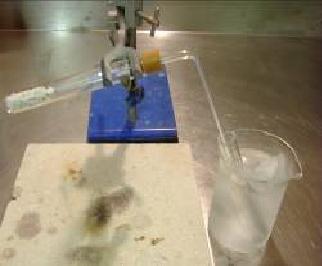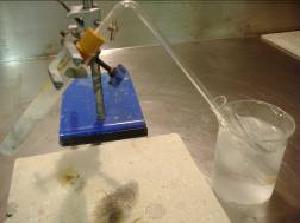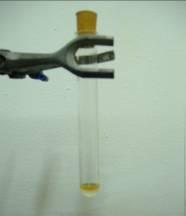killer_lapin
Harmless

Posts: 47
Registered: 23-7-2010
Location: Qc, CAN
Member Is Offline
Mood: No Mood
|
|
decarboxylation of terephthalic acid
hi,
I would like to know if one of you have and idea to decarboxylate terephthalic acid to benzene, i already try by distilling it with an intimate
mixture of CaO and H2O but the acid is vaporising before any reaction occur.
Now i want to try to vaporise the acid in a 500ml rb falsk and make the vapor pass trought a tube pack of CaO, heated on the side with a flame, so the
reaction will take place in vapor phase at 450-500 °C.
thanks
[Edited on 24-7-2010 by killer_lapin]
|
|
|
bbartlog
International Hazard
    
Posts: 1139
Registered: 27-8-2009
Location: Unmoored in time
Member Is Offline
Mood: No Mood
|
|
Are you sure the acid is vaporizing? It seems like you should get the calcium salt of the acid and that should be non-volatile up until it
decomposes... though the first decarboxylation would give you benzoic acid which I suppose might escape as vapor before the second carboxyl group was
eliminated. Anyway would be nice to know more about your setup before speculating further.
|
|
|
mr.crow
National Hazard
   
Posts: 884
Registered: 9-9-2009
Location: Canada
Member Is Offline
Mood: 0xFF
|
|
Are you using the disodium salt of the acid?
Double, double toil and trouble; Fire burn, and caldron bubble
|
|
|
killer_lapin
Harmless

Posts: 47
Registered: 23-7-2010
Location: Qc, CAN
Member Is Offline
Mood: No Mood
|
|
nop i'm using the acid form
no reaction occure, i recover the solid in my tube( the one which condense after vaporising) and i have made melting point test to see if it was
benzoic acid, it wasn't, and i used also infrared spectrocopy to confirm that, in conclusion it was still terephthalic acid!
[Edited on 24-7-2010 by killer_lapin]
[Edited on 24-7-2010 by killer_lapin]
|
|
|
hinz
Hazard to Others
  
Posts: 200
Registered: 29-10-2004
Member Is Offline
Mood: No Mood
|
|
Read this first:
http://www.sciencemadness.org/talk/viewthread.php?tid=325
http://www.sciencemadness.org/talk/viewthread.php?tid=4902
You need to form a terephthalate salt first, otherwise the terephthalic acid will sublimate before it decarboxylates.
Perhaps you shouldn't do it all in one pot, neutralize the terephthalic acid with CaO in one pot and than add 2 moles of CaO for each mole of
Ca-terepthalate, mix it, and put it into the heated tube. If these two steps are separated, you can vertify that all terephtalic acid is neutralized
and that there isn't any unreacted terephtalic acid around that sublimates.
I once tried the same reaction with NaOH and Na2(C8H4O4) (made from PET bottles) and got about 2-3 ml inpure benzene from about 300g mixture. Alot of
undefined gasses left the condensor, which burned but weren't benzene for sure.
[Edited on 24-7-2010 by hinz]
|
|
|
killer_lapin
Harmless

Posts: 47
Registered: 23-7-2010
Location: Qc, CAN
Member Is Offline
Mood: No Mood
|
|
i'm going to try that this week thanks!
|
|
|
Picric-A
National Hazard
   
Posts: 796
Registered: 1-5-2008
Location: England
Member Is Offline
Mood: Fuming
|
|
I use this reaction as my main source of benzene.
I use NaOH as i find yield are a lot better due to its low melting point so good contact when molten. I form the sodium salt beforehand because as you
say the TPA has a bad anoying tendency to sublime.
|
|
|
Taoiseach
Hazard to Others
  
Posts: 241
Registered: 16-3-2008
Member Is Offline
Mood: No Mood
|
|
Picric-A would you mind to elaborate on your procedure (what mixture did you destill and at what temperature)? I find it most fascinating that a route
from PET bottles to benzene has been developed. How is the yield and how much benzene did you make this way? Have you verified its purity yet?
if this really works it should be published as a nice .pdf file!
|
|
|
Picric-A
National Hazard
   
Posts: 796
Registered: 1-5-2008
Location: England
Member Is Offline
Mood: Fuming
|
|
There is a PDF file for the manufacture of TPA from PET. The decarboxylation has yet to be documented.
MY procedure involves forming the sodium salt of TPA followed by drying to a anhydrous white powder. This is then mixed with sodium hydroxide pearl in
a tin can attached to glass distillation set and heated strongly for a long time.
The product is a orange liquid. This can be fractionated to purify the benzene.
The main impurity is biphenyl, formed by the reversible equation; 2 C6H6 ↔ H2 + C12H10.
Fractional distillation would easily separate these however as biphenyl has a boiling point of 256 degrees C and benzene has one of 80.1 degrees C.
|
|
|
Taoiseach
Hazard to Others
  
Posts: 241
Registered: 16-3-2008
Member Is Offline
Mood: No Mood
|
|
| Quote: | | MY procedure involves forming the sodium salt of TPA followed by drying to a anhydrous white powder. This is then mixed with sodium hydroxide pearl in
a tin can attached to glass distillation set and heated strongly for a long time. |
What ratio of Na-TPA/NaOH do you use?
What heat source do you use?
| Quote: | | The product is a orange liquid. This can be fractionated to purify the benzene. |
Same as with the Na benzoate procedure. Do you think Na-TPA has an advantage over sodium benzoate?
|
|
|
Picric-A
National Hazard
   
Posts: 796
Registered: 1-5-2008
Location: England
Member Is Offline
Mood: Fuming
|
|
Honestly i would say Sodium benzoate has an advantage over Na-TPA however sodium benzoate is relativly expencive whereas Na-TPA is practically free! I
find Na benzoate is easier to decarboxylate/ quicker and produces less impurities however the TPA salt is fine and i have used to to produce >100ml
of benzene which is plenty.
If i remember correctly i used a 4 (or maybe 3...) molar excess of the sodium hydroxide required for decarboxylation. This is probably too much hoever
i found by using a large excess of the hydroxide i dont get left with the hard caked mass of refractory carbonate that other people have commented on.
This refractory mass is even worse with Ca(OH)2 hence i much prefer the sodium salt/hydroxide.
The ratio doesnt matter exactly, as long as you have over stoichiometric qtys of hydroxide.
I used a propane blow torch as it was all i had, idealy i would have used a propane/oxygen torch.
If i have time later on i will do a small scale reaction and take pictures to show you.
[Edited on 27-7-2010 by Picric-A]
|
|
|
Picric-A
National Hazard
   
Posts: 796
Registered: 1-5-2008
Location: England
Member Is Offline
Mood: Fuming
|
|
Ok, as promiced here are the pictures of the decarboxylation.
I performed this on test tube scale, using 2g Na-TPA and 6g NaOH.
The yield was just under 1ml of benzene.
  
|
|
|
Nicodem
Super Moderator
      
Posts: 4230
Registered: 28-12-2004
Member Is Offline
Mood: No Mood
|
|
Just under 1 mL of benzene from 2 g disodium terephthalate would be just under 118% yield. So I assume you are not talking about the benzene but about
the crude distillate before the actual isolation of benzene?
| Quote: | | The main impurity is biphenyl, formed by the reversible equation; 2 C6H6 ↔ H2 + C12H10. |
Have you actually isolated and characterized it, or is that just your guess? Biphenyl is indeed one of the side products as indicated in some paper
uploaded in some other thread on decarboxylation of benzoates, but it is not the only side product and it does not form via the reaction you wrote. It
would be however interesting if you managed to isolate any discrete compound from the distillation residue. How much of the higher boiling fractions
and residue is there anyway during the fractionation?
…there is a human touch of the cultist “believer” in every theorist that he must struggle against as being
unworthy of the scientist. Some of the greatest men of science have publicly repudiated a theory which earlier they hotly defended. In this lies their
scientific temper, not in the scientific defense of the theory. - Weston La Barre (Ghost Dance, 1972)
Read the The ScienceMadness Guidelines!
|
|
|
Picric-A
National Hazard
   
Posts: 796
Registered: 1-5-2008
Location: England
Member Is Offline
Mood: Fuming
|
|
Quote: Originally posted by Nicodem  |
Just under 1 mL of benzene from 2 g disodium terephthalate would be just under 118% yield. So I assume you are not talking about the benzene but about
the crude distillate before the actual isolation of benzene?
| Quote: | | The main impurity is biphenyl, formed by the reversible equation; 2 C6H6 ↔ H2 + C12H10. |
Have you actually isolated and characterized it, or is that just your guess? Biphenyl is indeed one of the side products as indicated in some paper
uploaded in some other thread on decarboxylation of benzoates, but it is not the only side product and it does not form via the reaction you wrote. It
would be however interesting if you managed to isolate any discrete compound from the distillation residue. How much of the higher boiling fractions
and residue is there anyway during the fractionation? |
Nicodem your right it was not 1ml of pure benzene, as you can see it is a mix of two layers and so i guessed the benzene layer has absorbed quite a
bit of water, leading to a higher volume (hence the 118% yield).
I manamged to identify biphenyl as an impurity by TLC comparison when i made 100ml of benzene from around 500g of TPA, there were obviously other
impurities in the post-distillstion mix however the biphenyl was easily identified. It was easy to see on the TLC plate under UV as it flouresced
strongly.
|
|
|
plante1999
International Hazard
    
Posts: 1936
Registered: 27-12-2010
Member Is Offline
Mood: Mad as a hatter
|
|
Does anyone know a catalyst, or reaction condition that could decarboxilate terephtalic acid?
I never asked for this.
|
|
|
deltaH
Dangerous source of unreferenced speculation
    
Posts: 1663
Registered: 30-9-2013
Location: South Africa
Member Is Offline
Mood: Heavily protonated
|
|
Speculative suggestion:
Possibly adsorbing the TPA onto silica gel, then heating to red heat might work and help to keep the number of by-products down. You'd probably have
quiet a bit of water coming off as well (simply by what was on the silica gell) so will need to decant the two layers that form from the condensate.
The rationale here is that the adsorption of the TPA on silica gel should help stave off rapid sublimation and allow you to get to high temperatures,
plus, simply being adsorbed on a surface can have a minor catalytic effect and this may be all that is necessary in this case, because more active
catalyst may also result in to many byproducts at such high temperatures.
|
|
|